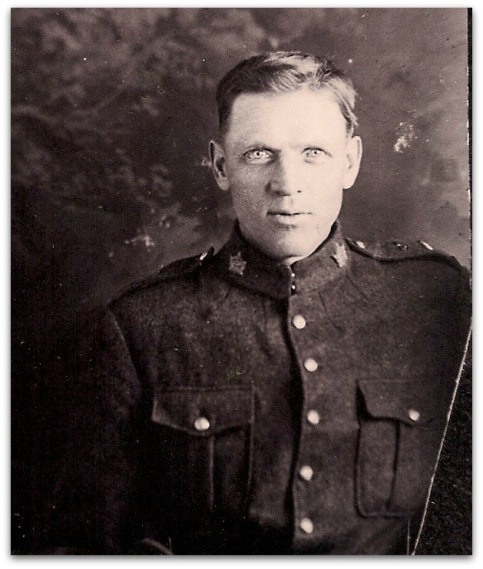
Date of Birth: March 17, 1883 at Black Avon, Antigonish County
Parents: Alexander and Ellen (Fraser) MacDonald
Siblings: Brothers Roderick, John, Archibald, James, William, Hugh, Joseph and Duncan (died young); sisters Mary Ellen, Catherine and Janet
Marital Status: Married
Occupation: Industrial Steel Worker
Enlistment: April 19, 1916, at Quebec, QC
Units: 57th Overseas (Canadien-Français) Battalion; 14th Battalion (Royal Montreal Regiment)
Service #: 449346
Rank: Private
Previous Military Service: None
Next of Kin: Lena MacDonald, Black Avon, Antigonish County (wife)
Date of Death: September 26, 1916 at Courcelette, France
Memorial: Canadian War Memorial, Vimy Ridge, France
Duncan MacDonald was born at Black Avon, Antigonish County, the son of Alexander and Ellen (Fraser) MacDonald. Alexander’s father, Archibald “Big Archie” MacDonald, was a native of Strathglass, Scotland and moved to Black Avon in 1826, on a farm first granted to Archie Chisholm, son of Donald “Gobha”. Big Archie’s two brothers, John “Iain Ban” and Hugh “Boghan Mor”, settled at Beaver Meadow.
Alexander, known as “Sandy Big Archie”, married Ellen Fraser, daughter of John (Pioneer) Fraser of James River (Mill Road). Alexander’s brother, Christopher “Mor,” was a merchant in Heatherton and was also engaged in the Newfoundland and coastal trade. Through his strict integrity, Christopher became favourably known, not only in his native district and county, but throughout the Maritimes. His ship, “Heather,” provided the impetus for changing the name of the former village of Pomquet Forks to Heatherton. Ellen’s brother, James, became a well-respected priest in the Diocese of Antigonish, while another brother, John, became a medical doctor in Massachusetts.
As with many Antigonish County men of the day, Duncan left home to find work. His brother, Archie, was a civil engineer working on bridge construction on Quebec and Duncan joined him as an industrial steel worker. He was also married, his wife Lena residing with his parents in the Black Avon family home at the time of his enlistment.
Duncan joined the 57th (Canadien-Français) Battalion on April 19, 1916. As there were few French Canadian battalions in the Canadian Expeditionary Force (CEF) at the time, the unit initially solicited francophone recruits, but faced a challenge attracting a full complement. The unit was considered for garrison duty in Bermuda, in relief of the 38th Battalion. Lieutenant Colonel Fages, who had commanded the Royal Canadian Regiment (RCR) in Bermuda and now oversaw the 5th Military District (eastern Quebec), unsuccessfully attempted to obtain more personnel from the 171st and the 189th Battalions. Sam Hughes, Minister of Militia, finally intervened and the 163rd was sent to Bermuda instead.
The 57th Battalion proceeded overseas on June 2, 1916, its personnel absorbed into the 69th Battalion and then the 10 Reserve Battalion—the feeder unit for Quebec battalions in the field—shortly after arriving in England. Duncan MacDonald was transferred to the 14th Battalion (Royal Montreal Regiment) before the end of June. Part of the 1st Canadian Division’s 3rd Brigade, the 14th had served in Belgium’s Ypres Salient for over a year, seeing action at St. Julien during the 2nd Battle of Ypres (April – May 1915) and at Mount Sorrel (June 1916).
During the late summer of 1916, the Canadian Corps moved southward, shifting its units from the Ypres Salient to the Somme region of France, where fighting had raged since the commencement of a major British offensive on July 1, 1916. British commanders relocated the Canadians in an effort to continue the British offensive, launched in part to relieve the pressure on French armies at Verdun. After arriving in early September, Canadian units assumed positions in front of Courcelette, a small village near Albert.
The 2nd and 3rd Canadian Divisions opened the attack northeast of Courcelette on September 15. Meanwhile, the 1st Canadian Division, which included Duncan’s 14th Battalion, remained in reserve. The 2nd Division captured the Village within 24 hours and had pushed northward into German-held territory. The 1st Division now entered the line, occupying the trenches between the 11th British and the 2nd Canadian Divisions. The 14th Battalion faced a location called “Kenora Trench,” one of two major German defenses lying in front of Thiepval Ridge. To their left, the 15th Battalion—their Brigade mates—faced “Hessian Trench, “while behind these two locations, along the crest of Thiepval Ridge, lay “Regina Trench,” the Corps’ final target.
On September 26, the 1st Division attacked the two key defensive positions, with support from the 2nd Division on its right and two British Divisions on its left. The 14th and 15th Battalions captured the two trenches after several hours of brutal combat, but fighting continued for three days as German forces launched a series of savage counterattacks that eventually recaptured the positions. The fighting marked the beginning of the “Battle of Thiepal Ridge,” continuing for more than a month before Canadian units successfully captured Regina Trench.
Private Duncan MacDonald was officially reported “missing” after the first day’s fighting. He never returned to his unit and his remains were never retrieved from the battlefield. His Circumstances of Casualty card states: “Previously reported missing, now killed in Action“ during an “Attack North west of Courcelette.” Duncan’s name is inscribed on the Canadian War Memorial at Vimy Ridge, France, one of more than 11,000 Canadian soldiers lost in northern France and whose final resting place is unknown.
Thinking of you today Duncan xo
LikeLiked by 1 person
Eillieen, Are you a relative of Mr. Duncan MacDonald? His Grandfathers brothers ” John Iain ban” and Hugh “boghan Mor” are listed in my family tree.
LikeLike